Astronomers have discovered a new, slimmer kind of red giant star, which they liken to “finding Wally.” In the Milky Way, there are only about 40 of these stars.
 In the binary named Mira, a red giant star transfers mass to a white dwarf. Image Credit: © NASA/CXC/M.Weiss.
In the binary named Mira, a red giant star transfers mass to a white dwarf. Image Credit: © NASA/CXC/M.Weiss.
For the first time, astronomers at the University of Sydney have discovered a slimmer type of red giant star. These stars have lost a lot of weight, possibly as a result of a greedy stellar companion. The discovery was published in the journal Nature Astronomy and is a significant step forward in understanding the lives of stars in the Milky Way, the nearest neighbors.
It’s like finding Wally. We were extremely lucky to find about 40 slimmer red giants, hidden in a sea of normal ones. The slimmer red giants are either smaller in size or less massive than normal red giants.
Mr. Yaguang Li, Study Lead Author and PhD Candidate, University of Sydney
Why and how did they lose weight? The majority of stars in the sky are in binary systems, which are made up of two stars that are gravitationally linked to one another. When stars in close binaries expand, as they do as they get older, some material can reach their companion’s gravitational sphere and be sucked away.
In the case of relatively tiny red giants, we think a companion could possibly be present.
Mr. Yaguang Li, Study Lead Author and PhD Candidate, University of Sydney
An Intragalactic Treasure Hunt
The researchers looked at data from NASA’s Kepler space telescope that had been archived. The telescope recorded brightness variations on tens of thousands of red giants from 2009 to 2013. The group carried out a thorough census of this stellar population using this extremely accurate and large dataset, laying the groundwork for spotting any outliers.
Very low-mass red giants and underluminous (dimmer) red giants were discovered to be two types of unusual stars.
The very low-mass stars have a solar mass of 0.5 to 0.7, which is roughly half that of the Sun. The weight of the very low-mass stars would indicate that they were older than the age of the Universe if they had not unexpectedly lost weight, which is impossible.
Mr. Li adds, “So, when we first obtained the masses of these stars, we thought there was something wrong with the measurement. But it turns out there wasn’t.”
The normal masses of the underluminous stars, on the other hand, range from 0.8 to 2.0 solar masses.
However, they are much less ‘giant’ than we expect. They’ve slimmed down somewhat and because they’re smaller, they’re also fainter, hence ‘underluminous’ compared to normal red giants.
Dr. Simon Murphy, Study Co-Author, University of Southern Queensland
Only seven such dimly lit stars were discovered, but the authors believe there are many more lurking in the sample. “The problem is that most of them are very good at blending in. It was a real treasure hunt to find them,” Dr. Murphy added.
Simple stellar evolution predictions could not account for these unusual data points. This led investigators to believe that another mechanism is at work, forcing these stars to lose significant weight: nearby stars stealing mass.
Stellar Population Census
The properties of the red giants were determined using asteroseismology, which is the study of stellar vibrations.
The surface properties of a star, such as surface temperature and luminosity, are studied using conventional methods. Astroseismology, on the other hand, uses sound waves to delve deeper. “The waves penetrate the stellar interior, giving us rich information on another dimension,” Mr. Li said.
With this method, the investigators were able to accurately determine the evolutionary stages, masses and sizes of stars. When they looked at the distributions of these properties, they noticed something unusual: some stars have very small masses or sizes.
“It is highly unusual for a PhD student to make such an important discovery. By sifting carefully through data from NASA’s Kepler space telescope, Yaguang spotted something that everyone else had missed,” remarked Professor Tim Bedding, Mr. Li’s academic supervisor.